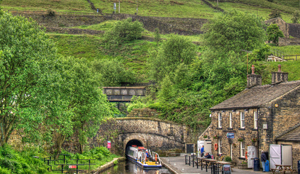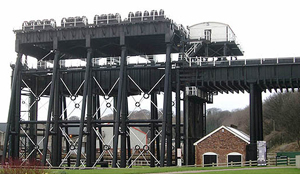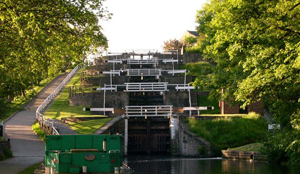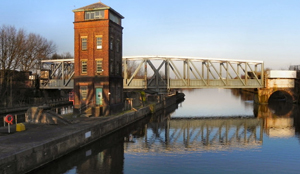Just over 50 years ago, Robert Aickman, the co-founder of the Inland Waterways Association published his book ‘Know Your Waterways’. Within its covers, he compiled what became to be known as his Seven Wonders of the Waterways.
Times change however, and since his death in 2002, other structures have come to challenge his original seven. Some remain constant – The Pontcysyllte Aqueduct for instance, but new projects come along, and engineering marvels such as the spectacular Falkirk Wheel now find themselves included in a modern, updated version of the original. I list seven below which I regard merit inclusion in the latest ‘Seven Wonders of the Waterways – others will have structures that they consider should be included – but that is one of the wonderful features of the Canal and River Network of the UK – everyone has their own favourites! Long may it continue…
The Pontcysyllte Aqueduct, Clywd
 This mighty structure carries the Llangollen Canal 38 metres (126ft) high above the River Dee. I shall never forget the jaw dropping view the first time I crossed it – you felt as if the boat was flying (a sensation heightened by the fact that one side of the structure has no hand rail at all!) Now a World Heritage site, the Pontcysyllte Aqueduct is the highest and longest aqueduct in Britain. Taking ten years to build between 1795 and 1805, it has eighteen magnificent piers made of local stone and a 307-metre (1007ft) long iron trough that takes the canal over the valley.
This mighty structure carries the Llangollen Canal 38 metres (126ft) high above the River Dee. I shall never forget the jaw dropping view the first time I crossed it – you felt as if the boat was flying (a sensation heightened by the fact that one side of the structure has no hand rail at all!) Now a World Heritage site, the Pontcysyllte Aqueduct is the highest and longest aqueduct in Britain. Taking ten years to build between 1795 and 1805, it has eighteen magnificent piers made of local stone and a 307-metre (1007ft) long iron trough that takes the canal over the valley.
The Falkirk Wheel, Falkirk, Stirlingshire
 Incongruous it may seem on an old canal system, it cannot be denied that the Falkirk Wheel is a unique structure. It forms part of the Millennium Link project which set out to restore the canals which linked the east and west coasts of Scotland. Costing in excess of £17million, the Falkirk Wheel wheel is the world’s only rotating boat lift. At 115ft in height, the wheel replaces 11 locks that were dismantled in 1933, and has the capacity to lift 600 tonnes.
Incongruous it may seem on an old canal system, it cannot be denied that the Falkirk Wheel is a unique structure. It forms part of the Millennium Link project which set out to restore the canals which linked the east and west coasts of Scotland. Costing in excess of £17million, the Falkirk Wheel wheel is the world’s only rotating boat lift. At 115ft in height, the wheel replaces 11 locks that were dismantled in 1933, and has the capacity to lift 600 tonnes.
The Caen Hill Flight, Devizes, Wiltshire
 This is one of those locations boaters love or hate. With 29 locks in total, the flight rises 237 feet in the space of two miles. However 16 of those locks form a straight line, and represent a daunting six hours work for most boat crews. Once again, this flight had to be restored after the canal was left derelict in 1950. Major restoration work was undertaken throughout the 70’s and 80’s and the flight was finally reopened for navigation in 1990.
This is one of those locations boaters love or hate. With 29 locks in total, the flight rises 237 feet in the space of two miles. However 16 of those locks form a straight line, and represent a daunting six hours work for most boat crews. Once again, this flight had to be restored after the canal was left derelict in 1950. Major restoration work was undertaken throughout the 70’s and 80’s and the flight was finally reopened for navigation in 1990.
The Standedge Tunnel, Standedge, near Marsden, West Yorkshire

The Standedge Tunnel runs for over three miles, carrying the Huddersfield Narrow Canal beneath the hard rock of the Pennine Hills. It was originally opened in 1811 having taken an incredible 17 years to dig, but like so much of the canal system was left to fall into dereliction – the last commercial use of the tunnel was in 1921 and it finally closed to navigation during the Second World War. This fantastic example of civil engineering is the longest, highest and deepest tunnel on the canal system. An extensive programme of restoration took place which finally saw the tunnel reopen in 2001.
The Anderton Boat Lift, near Northwich, Cheshire

This beastie is known locally as The Cathedral of the Canals, and drops boats 50ft down to the River Weaver from the Trent & Mersey Canal. It was originally designed by Edwin Clark and was finally opened in 1875. The structure itself consists of two caissons (large water filled troughs) wide enough to take a pair of narrowboats side by side. Just over a hundred years later, problems with the mechanism forced the entire structure to close. Following years of campaigning, the boat lift was restored and it finally reopened in 2002
The Bingley Five Rise Locks, Bingley, West Yorkshire

This spectacular structure was built in 1774, and forms a steep staircase of locks on the Leeds & Liverpool Canal. Raising or lowering narrowboats in five large connected chambers, the Bingley Five Rise forms the steepest flight of locks in the UK, falling 60ft from the top in just 106 yards.
The Barton Swing Aqueduct, Barton-upon-Irwell, Greater Manchester
 An original aqueduct was constructed by James Brindley in 1761 to take the Bridgewater Canal across the River Irwell, and this first stone aqueduct was considered a marvel of the age. However, when the Manchester Ship Canal Co decided to use the course of the River Irwell in 1893 as part of its navigation channel, James Brindley’s creation was replaced by the existing Barton Swing Aqueduct.
An original aqueduct was constructed by James Brindley in 1761 to take the Bridgewater Canal across the River Irwell, and this first stone aqueduct was considered a marvel of the age. However, when the Manchester Ship Canal Co decided to use the course of the River Irwell in 1893 as part of its navigation channel, James Brindley’s creation was replaced by the existing Barton Swing Aqueduct.
To allow ships passage along the Ship Canal, the 330-ft trough full of water, weighing an incredible 1450 tonnes, rotates through a full 90 degrees.
